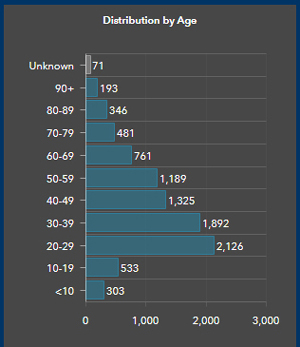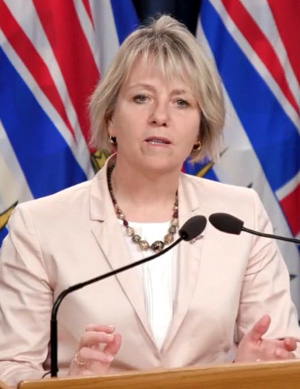
Thursday October 1, 2020 | VICTORIA, BC
by Mary P Brooke, B.Sc., Editor | Island Social Trends
There have been 9,220 cases of COVID-19 in BC to date, with 82 of those new today. There are 1,261 active cases and 3,093 people are under active public health monitoring due to identified exposure.
In today’s statistics there are new cases across all age groups. That includes five more cases in children under the age of 10 (total 303) and 11 new cases in tweens-and-teens of ages 10 to 19 (total 533). The number of COVID cases among children has been steady rising each day, for two months now.
The age group with the highest number of cases is 20-29 year of age — with 20 new cases, bringing that age group total to 2,126.
That is followed closely by the 1,819 total case tally for the 30-39 age group (with 16 new today).
Unlike in the earlier phase of the pandemic this year when most new cases were among seniors, during the last two weeks all age groups have seen steady additions to case numbers.
Seniors in the 60-69 year age group (generally still active in the economy and community) saw 17 new cases in today’s stats. That’s in the same ballpark as other adult age ranges in the October 1 BC CDC COVID stats:
- age 20-29: +20 (total 2,126)
- age 30-39: +16 (total 1,892)
- age 40-49: +11 (total 1,325)
- age 50-59: +15 (total 1,189)
- age 60-69: +17 (total 761)
Even the elderly set is seeing larger daily case numbers in recent weeks compared to summer.
- age 70-79: +7 (total 481)
- age 80-89: +4 (total 346)
- age 90+: +5 (total 193)
Staff and residents in long-term care:
There’s been another outbreak in long-term care, a recurrence notes Dr Henry. That involves a single health-care worker in Fraser Health.
Presently there are 18 active outbreaks: 15 in long-term care and three in acute care. Within those facilities, a total of 860 test-positive cases have happened in 2020 during the pandemic: 513 residents and 347 staff.
COVID test volume & types of tests:
The testing for COVID-19 in BC is robust. On October 1 the ‘new test’ tally is 10,901 (over the past 24 hours), with 1,107 of those done on Vancouver Island.
Negative tests results can be obtained online or by phone/text. Users of ehealth have the choice to receive an email alert when new test results are ready.

The nasal-pharyngeal swab test is the most reliable, according to Provincial Health Office Dr Bonnie Henry today.
The swish-gargle-spit test is slightly less reliable but can be done at home which is convenient for the individual and saves on health-care worker time; it is thought to be easier (and/or less invasive) for children, but kids under age five are less likely to handle the many steps or be able to gargle without swallowing. | September 17 article about Dr Henry’s promotion of the swish-gargle test.
In BC, testing is available for people who have symptoms.
COVID test resource management – it’s all about the reagents:

In response to a question from Island Social Trends earlier this week, Dr Henry said that BC is not presently offering COVID-19 testing at commercial pharmacies. This has partly to do with a high demand for the reagents that are used in the test; she therefore wants to see resources used where the likelihood of finding positive test results is highest.
COVID-19 tests require complex and pure reagents, such as enzymes, probes, and primers that are created to match the coronavirus’s genome, in addition to inorganic solutions. These are in high demand across Canada and around the world.
The COVID-19 crisis has underscored vulnerability to reagent shortages brought on by sudden demand, export bans, and stockpiling. Scarcity is compounded by problems like limited production capacity and a market dominated by just a few firms.
Up until COVID hit, there was usually enough capacity to run the range of tests that labs do. The pandemic has forced an unexpected upscaling of production.
In Ontario, where 60 pharmacies offer COVID-19 testing, that is generally for people who suspect they might have the infection but are presently not showing symptoms. Anyone with symptoms goes through the regular public health system. People who access the test through pharmacies in Ontario are phoned ahead of time, must answer a series of questions, and must make an appointment. That’s to limit any possible COVID exposure to others in the retail setting (staff and customers).
Hospitalizations:
There have been 779 people in hospital to date in BC due to COVID-19 — currently 69 (16 in intensive care).
There was one new COVID-related death in today’s BC Centre for Disease Control (BC CDC) statistics. The total year to date is 235.

Vancouver Island profile:
There was one new case on Vancouver Island today, in the 20-29 age group. Total cases now 209. Four cases are active.
Hospitalizations stand at 25 to date on the island, but no one is presently hospitalized in Island Health. There have been six deaths this year to date on Vancouver Island during COVID (the latest one just this week, a man who died at home with COVID only determined post-mortem).
On Vancouver Island 199 cases are listed as recovered.

Safe Halloween requires COVID-awareness:

The BC CDC COVID Halloween guidelines are now online under a category called ‘safer celebrations’. [October 2 update]
Behind the statistics:
As everyone knows, behind the COVID-19 statistics are all the impacted families, disrupted communities and businesses, and changes in how we carry out our daily lives and social relationships. The mental health impacts of this sudden loss and massive shifts will have ripple effects in society for decades.



